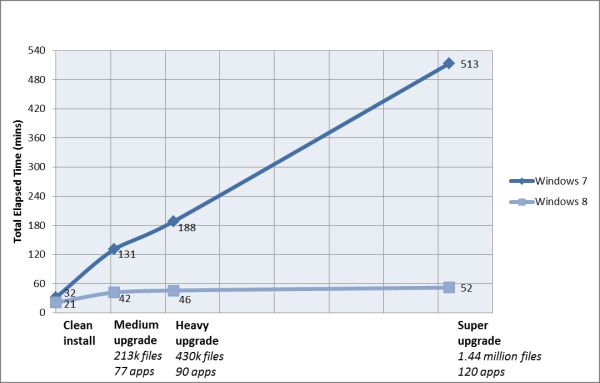Windows 8 to Feature Streamlined Downloadable Installer
by Andrew Cunningham on November 22, 2011 11:00 AM ESTAs with every new Windows version, Microsoft is streamlining the Windows setup process, writes Christa St. Pierre on the Building Windows 8 Blog. The biggest change is the new online installer for Windows 8, which can download the installation media directly from Microsoft's servers and install the operating system without so much as bothering the user for a product key (for upgrade installs). Those wanting to do clean or advanced installs will be given the option to copy the installation files to a DVD or USB drive.
Windows 8 will further streamline the upgrade process by folding both Windows Upgrade Advisor, which scans your computer for hardware and software and checks its compatibility with Windows 8, and Windows Easy Transfer, which allows easy and granular controls for backing up and restoring files and settings, into the Windows installer rather than keeping them as separate applications. The new installer will be able to upgrade OSes as old as Windows XP (which will preserve only user data), though users upgrading from Windows Vista or Windows 7 will also be given the option to preserve Windows settings and applications, respectively.
Lastly, Microsoft has made changes to how the upgrade install works with user files to reduce the amount of time taken. Previous installers would move user files to a temporary location, install the OS, and then move them back. The Windows 8 installer reduces the number of file moves, and uses "hard links" to files to change their location in the file structure without physically moving the data around. Microsoft's graph below shows a drastic reduction in time for an upgrade install under Windows 8.
For those of you who prefer boxed software, Microsoft will continue to sell boxed copies of Windows on DVD. Users who initiate the install by booting from a DVD or USB drive will continue to see more advanced options for performing clean installs and partitioning disks. Enterprise administrators and power users who need more customization options can continue to use Microsoft suite of deployment tools (now called the Windows Assessment and Deployment Kit, or ADK).
For more details, check out the post at the Building Windows 8 Blog.
Source: Building Windows 8 Blog











28 Comments
View All Comments
ananduser - Tuesday, November 22, 2011 - link
You should take not of what solipsism says. He doesn't have 25k posts on AppleInsider for nothing. He knows his Apple gear well.B3an - Wednesday, November 23, 2011 - link
You are one stereotypically thick Apple user.iPhone and all the iToys do NOT run OSX. iOS is completely different to OSX, the interface and everything. Plus apps for iOS dont run on OSX do they. God you're thick.
If you're going to say that iOS is OSX then you can also say that Windows Phone is Windows being as it uses code from Windows so it must be a "streamlined" version.
Windows 8 will be the exact same OS on all devices bar phones, for now.
solipsism - Friday, November 25, 2011 - link
Funny how Apple was the one to differentiate OS X into two groups: Mac OS and iPhone OS, now iOS…. but if you had better reading comprehension you would already known this.There is even a big ass fucking banner from when they introduced their iPhone SDK: [link]http://assets.gearlive.com/blogimages/wwdc-os-x-ip...[/link]
smjain - Saturday, November 26, 2011 - link
Hate to break it to you but MS split Windows years and years ago into the desktop and PDA? Remember Windows CE (released 1996), Windows PocketPC, and Windows Mobile? Then before there was an iPhone, there were Windows Mobile phones running, you guessed it, Windows Mobile. The first smartphone running Windows Mobile was back in 2003. Guess what, it even had apps! There were versions of Office, that could open the desktop versions documents, etc.solipsism - Sunday, November 27, 2011 - link
WinCE and it's evolution is not the same OS or kernel as desktop Windows or the Windows ES that followed much later. Even now WP7 is based off of WinCE, not a trimmed version of Windows 7.Fritzr - Wednesday, November 30, 2011 - link
It might shock you to know that WinNT & Win16 were completely different OSes and later merged to become WinXP.WinCE similarly was a Windows OS that was largely compatible with the consumer version.
WinMobile & WP7 & are direct descendants of WinCE and have enjoyed the same name changing that the mainstream Windows has undergone.
Apple uses 3 unique OSes currently that cannot easily port code across.
Microsoft maintains 3 unique OSes (XBox is the other one) and keeps the APIs close enough to make life easy for porters.
With Win8 they are creating a stripped version of the full desktop OS (x86 support removed) to ARM devices. They are demoing a UI that would be usable on an ordinary non-touch phone.
Microsoft is definitely not copying Apple in this process of streamling their entire lineup. This is something Microsoft started doing in the 1980's and IBM and others were doing in the 1960's
Apple may be doing it also, but they are definitel not innovators on this basis.
solipsism - Friday, November 25, 2011 - link
Here's another view: http://www.roughlydrafted.com/wp-content/uploads/2...I've shown how Mac OS X 10.7.0 and iOS 5.0 are using the same OS (Darwin 11.0.0), now show me where WP7, Win7, and XBOX360 are all using the same fork and even close to the same kernel.
JKflipflop98 - Thursday, November 24, 2011 - link
I like how when MS makes a derivative it's a "bastardized" version, but when your beloved Apple does it, it's a "streamlined" version. LOL GTFO of here with your garbage.Taft12 - Tuesday, November 22, 2011 - link
MS is only interested in copying something AFTER Apple does it first.wonderfield - Tuesday, November 22, 2011 - link
He didn't claim Apple invented any of these things.